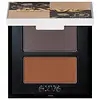What's inside
What's inside
 Key Ingredients
Key Ingredients

 Benefits
Benefits

 Concerns
Concerns

 Ingredients Side-by-side
Ingredients Side-by-side

Diisopropyl Adipate
EmollientJojoba Esters
EmollientOctyldodecanol
EmollientSucrose Acetate Isobutyrate
Isostearyl Behenate
EmollientBis-Diglyceryl Polyacyladipate-2
EmollientCopernicia Cerifera Wax Extract
Squalane
EmollientPolyhydroxystearic Acid
EmulsifyingMica
Cosmetic ColorantTridecyl Trimellitate
EmollientSynthetic Wax
AbrasivePolybutene
Behenyl Behenate
EmollientCaprylic/Capric Triglyceride
MaskingSilica
AbrasiveTocopherol
AntioxidantLecithin
EmollientParfum
MaskingCellulose
AbsorbentHydrogenated Lecithin
EmulsifyingLimonene
PerfumingAlpha-Isomethyl Ionone
PerfumingBenzyl Salicylate
PerfumingGeraniol
PerfumingHydroxycitronellal
PerfumingCoumarin
PerfumingLinalool
PerfumingCitral
PerfumingCitronellol
PerfumingCI 77491
Cosmetic ColorantCI 77891
Cosmetic ColorantLauroyl Lysine
Skin ConditioningZinc Stearate
Cosmetic ColorantEthylhexyl Palmitate
EmollientBoron Nitride
AbsorbentCaprylyl Glycol
EmollientSorbic Acid
PreservativeCI 77007
Cosmetic ColorantCI 77742
Cosmetic ColorantDiisopropyl Adipate, Jojoba Esters, Octyldodecanol, Sucrose Acetate Isobutyrate, Isostearyl Behenate, Bis-Diglyceryl Polyacyladipate-2, Copernicia Cerifera Wax Extract, Squalane, Polyhydroxystearic Acid, Mica, Tridecyl Trimellitate, Synthetic Wax, Polybutene, Behenyl Behenate, Caprylic/Capric Triglyceride, Silica, Tocopherol, Lecithin, Parfum, Cellulose, Hydrogenated Lecithin, Limonene, Alpha-Isomethyl Ionone, Benzyl Salicylate, Geraniol, Hydroxycitronellal, Coumarin, Linalool, Citral, Citronellol, CI 77491, CI 77891, Lauroyl Lysine, Zinc Stearate, Ethylhexyl Palmitate, Boron Nitride, Caprylyl Glycol, Sorbic Acid, CI 77007, CI 77742
Octyldodecanol
EmollientMica
Cosmetic ColorantTridecyl Trimellitate
EmollientRicinus Communis Seed Oil
MaskingHelianthus Annuus Seed Wax
Skin ConditioningHydrogenated Vegetable Oil
EmollientTribehenin
EmollientButyrospermum Parkii Butter
Skin ConditioningNymphaea Caerulea Flower Extract
Skin ConditioningJojoba Esters
EmollientSilica
AbrasiveSqualane
EmollientCaprylic/Capric Triglyceride
MaskingDimethyl Isosorbide
SolventOleic/Linoleic/Linolenic Polyglycerides
EmollientTocopheryl Acetate
AntioxidantSesamum Indicum Seed Extract
Skin ConditioningTocopherol
AntioxidantIron Oxides
CI 15850
Cosmetic ColorantCI 77891
Cosmetic ColorantOctyldodecanol, Mica, Tridecyl Trimellitate, Ricinus Communis Seed Oil, Helianthus Annuus Seed Wax, Hydrogenated Vegetable Oil, Tribehenin, Butyrospermum Parkii Butter, Nymphaea Caerulea Flower Extract, Jojoba Esters, Silica, Squalane, Caprylic/Capric Triglyceride, Dimethyl Isosorbide, Oleic/Linoleic/Linolenic Polyglycerides, Tocopheryl Acetate, Sesamum Indicum Seed Extract, Tocopherol, Iron Oxides, CI 15850, CI 77891
Ingredients Explained
These ingredients are found in both products.
Ingredients higher up in an ingredient list are typically present in a larger amount.
This ingredient is an emollient, solvent, and texture enhancer. It is considered a skin-softener by helping the skin prevent moisture loss.
It helps thicken a product's formula and makes it easier to spread by dissolving clumping compounds.
Caprylic Triglyceride is made by combining glycerin with coconut oil, forming a clear liquid.
While there is an assumption Caprylic Triglyceride can clog pores due to it being derived from coconut oil, there is no research supporting this.
Learn more about Caprylic/Capric TriglycerideCi 77891 is a white pigment from Titanium dioxide. It is naturally found in minerals such as rutile and ilmenite.
It's main function is to add a white color to cosmetics. It can also be mixed with other colors to create different shades.
Ci 77891 is commonly found in sunscreens due to its ability to block UV rays.
Learn more about CI 77891Jojoba Esters is a wax created from Jojoba oil. It is an emollient and film-forming ingredient. In bead form, it is an exfoliator.
This ingredient has high oxidative stability, meaning it doesn't break down when exposed to oxygen.
Its similarity to our skin's natural oils makes it a great emollient. Emollients help soften and soothe our skin by creating a barrier on top. This barrier helps trap moisture in, keeping skin hydrated.
It is created using either the hydrogenation or transesterification processes on jojoba oil.
Learn more about Jojoba EstersMica is a naturally occurring mineral used to add shimmer and color in cosmetics. It can also help improve the texture of a product or give it an opaque, white/silver color.
Serecite is the name for very fine but ragged grains of mica.
This ingredient is often coated with metal oxides like titanium dioxide. Trace amounts of heavy metals may be found in mica, but these metals are not harmful in our personal products.
Mica has been used since prehistoric times throughout the world. Ancient Egyptian, Indian, Greek, Roman, Aztec, and Chinese civilizations have used mica.
Learn more about MicaOctyldodecanol is a fatty alcohol. It is primarily used to enhance the texture of products.
As an emulsifier, Octyldodecanol helps prevent the oils and waters from separating. It also prevents ingredients from creating foam when shaken.
Octyldodecanol is created by reducing fatty acid to an alcohol.
Due to its high molecular weight, it does not get absorbed into the skin.
Learn more about OctyldodecanolSilica, also known as silicon dioxide, is a naturally occurring mineral. It is used as a fine, spherical, and porous powder in cosmetics.
Though it has exfoliant properties, the function of silica varies depending on the product.
The unique structure of silica enhances the spreadability and adds smoothness, making it a great texture enhancer.
It is also used as an active carrier, emulsifier, and mattifier due to its ability to absorb excess oil.
In some products, tiny microneedles called spicules are made from silica or hydrolyzed sponge. When you rub them in, they lightly polish away dead skin layers and enhance the penetration of active ingredients.
Learn more about SilicaSqualane is an emollient that helps the skin hold onto moisture. It's an oily liquid that occurs naturally in certain types of fish and plant oils.
Because squalane boosts hydration in the skin, it also comes with plenty of benefits: it is an antioxidant and can help fight free radicals and skin damage. Squalane is also found to have a detoxifying effect when applied.
Squalane comes from squalene, which occurs naturally within the sebum of our skin. It is one of the oils our skin produces to keep itself hydrated. Squalane is the hydrogenated version of squalene and has a longer shelf life.
Research shows that squalane is non-irritating (even at 100% concentration).
In general, it's a fantastic ingredient. It does a great job at hydrating the skin, and it's suitable for those with sensitive skin.
The source of squalane may impact malassezia / fungal acne. This is because olive oil derived squalane can contain impurities such as fatty acids and plant waxes. Sugarcane derived squalane is recommended for anyone with malassezia concerns.
Is squalane vegan?
This depends on the source. Squalane can be derived from both plants and animals. Most squalane used in skincare comes from plants.
Please note: the source of squalane is only known if disclosed by the brand. We recommend reaching out to the brand if you have any questions about their squalane.
Read more about squalene with an "e".
Is squalane an oil?
Squalane is often called an oil, but it’s technically not; it’s a hydrocarbon, meaning it’s only made of carbon and hydrogen, unlike true oils which are triglycerides made of fatty acids and glycerol.
The term “oil-free” isn’t regulated, so companies can define it however they want. Some exclude all oils, while others just avoid mineral oil or comedogenic oils.
While some people avoid oils thinking they cause breakouts, the right kind of oil (or oil-like ingredient like squalane) can actually help balance and hydrate your skin. It’s worth testing out simple oils or squalane to see what works best for your skin.
Learn more about SqualaneTocopherol (also known as Vitamin E) is a common antioxidant used to help protect the skin from free-radicals and strengthen the skin barrier. It's also fat soluble - this means our skin is great at absorbing it.
Vitamin E also helps keep your natural skin lipids healthy. Your lipid skin barrier naturally consists of lipids, ceramides, and fatty acids. Vitamin E offers extra protection for your skin’s lipid barrier, keeping your skin healthy and nourished.
Another benefit is a bit of UV protection. Vitamin E helps reduce the damage caused by UVB rays. (It should not replace your sunscreen). Combining it with Vitamin C can decrease sunburned cells and hyperpigmentation after UV exposure.
You might have noticed Vitamin E + C often paired together. This is because it is great at stabilizing Vitamin C. Using the two together helps increase the effectiveness of both ingredients.
There are often claims that Vitamin E can reduce/prevent scarring, but these claims haven't been confirmed by scientific research.
Learn more about TocopherolTridecyl Trimellitate is a synthetic ingredient with emollient and skin conditioning properties. It also acts as a texture enhancer and helps products spread easily without feeling greasy.
As an emollient, it forms a light layer on the skin that keeps moisture in and improves water resistance. This is why you'll often find this ingredient in eye creams and other rich treatments.
This ingredient is seen as the elegant alternative to mineral oil.
Learn more about Tridecyl Trimellitate